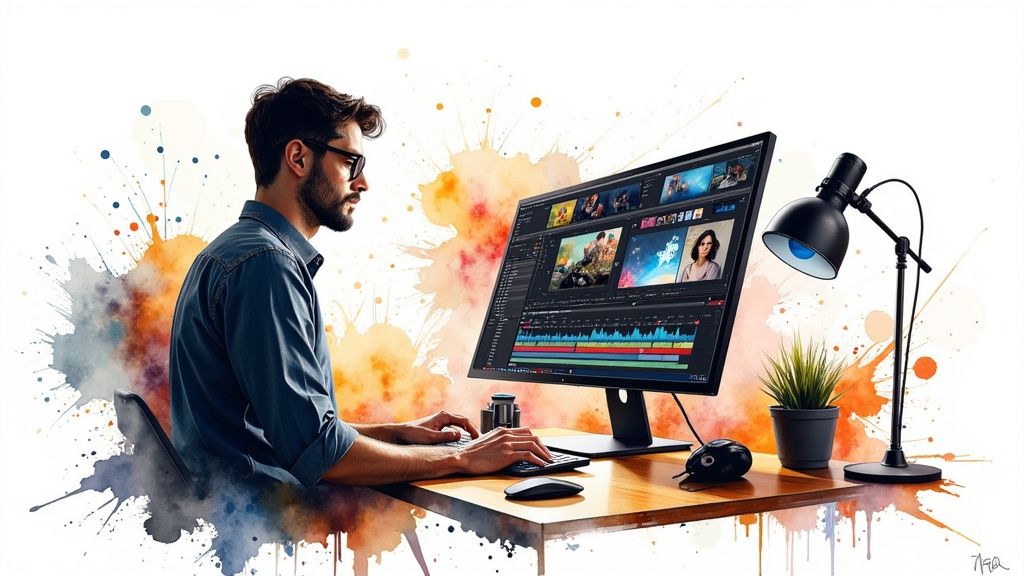The Modern Content Creation Landscape

Creating engaging content consistently is no small feat in today's fast-paced environment. Success depends heavily on choosing and using the right content creation tools effectively. Recent studies back this up - 64.7% of B2C companies now use AI tools in their content workflows to boost results. This shift shows how critical these tools have become for staying competitive and meeting audience demands.
Key Content Creation Challenges
Content creators face several major hurdles in their day-to-day work. The sheer volume of content needed across multiple platforms can be overwhelming. Beyond quantity, maintaining authentic connections with audiences while scaling up production is equally challenging. Generic content simply won't cut it anymore - audiences want personalized experiences that speak to them directly. Add constantly shifting platform algorithms and evolving audience preferences to the mix, and it becomes clear why having the right tools and strategies is essential.
Balancing Scale and Quality
Modern content tools offer practical solutions to these challenges. For example, AI writing tools can spark new ideas, create first drafts, and optimize content for different platforms. But these tools work best when they complement rather than replace human creativity. Think of them as capable assistants that handle repetitive tasks, giving creators more time for strategic thinking and authentic storytelling. This balanced approach helps teams produce more content while keeping quality high. For more insights, check out: 10 Best Tools for Content Creation That Drive Exceptional Results.
Learning From Top Content Creators
The most successful content creators know that planning matters as much as execution. They use tools strategically across their workflow - from content calendars to audience research to performance tracking. They closely monitor analytics to understand what content connects best with their audience and adjust their approach based on real data. Strong team collaboration tools keep communication smooth and review processes efficient. This combination of data-driven decisions and seamless teamwork helps them build engaged communities around their content.
Essential Tools for Today's Creator
This table breaks down the key tools that help modern content creators succeed:
| Tool Category | Key Benefits |
|---|---|
| AI Writing Assistants | Idea generation, drafting, content optimization, increased efficiency. |
| Visual Content Tools | Creation of engaging visuals, enhanced brand aesthetic, improved audience engagement. |
| Strategic Planning | Content calendar management, audience research, performance tracking, data-driven decisions. |
| Distribution & Analytics | Content distribution optimization, performance analysis, ROI improvement. |
| Collaboration Tools | Streamlined workflows, effective communication, brand consistency. |
The right mix of these tools, paired with clear strategy and genuine creativity, helps content creators meet today's challenges while building lasting connections with their audiences. Success comes from finding the right balance between efficiency and authenticity in your content creation process.
AI Writing Assistants That Actually Deliver Results
Content creators are seeing real business impact from AI writing tools that go beyond basic automation. The most effective tools are helping creators produce higher-quality content more efficiently while maintaining their unique voice and style. Recent data shows businesses integrating AI content tools have seen engagement rates climb by 6.2%, proving these tools can deliver measurable value when used strategically.
Streamlining Content Workflows with AI
The most successful creators use AI writing tools to handle time-consuming routine tasks in their content process. From creating first drafts to adapting content for different channels, AI assistants take care of the mechanical aspects of writing. For example, when a creator needs to turn a long blog post into social media content, AI can quickly generate multiple caption options - freeing up time for higher-value creative work. This approach helps solve the challenge of producing more content without sacrificing quality.
Enhancing Creativity and Ideation
Beyond just automating writing tasks, AI tools can actively support the creative process. By analyzing content trends and patterns, AI helps creators discover fresh angles on topics, overcome creative blocks, and identify promising new content directions. This allows creators to push their work in new directions while staying relevant to their audience's interests. The AI serves as a creative collaborator, offering perspectives that can spark original ideas.
Maintaining Authenticity and Voice
While some worry about AI making content sound robotic, top AI writing tools actually help creators protect and strengthen their unique voice. Many platforms can learn from samples of a creator's writing to match their natural style and tone. Advanced features for analyzing sentiment and adjusting emotional resonance give creators precise control over how their message comes across. When used thoughtfully, AI amplifies rather than replaces the creator's authentic voice.
Integrating AI into Team Workflows
Leading content teams are thoughtfully incorporating AI writing tools into their existing processes. Rather than replacing human writers, AI helps team members work more effectively by handling routine tasks. This frees up creators to focus on strategy, research, and crafting compelling narratives. The most successful teams find the right balance - using AI to boost efficiency while ensuring content maintains a human touch and aligns with brand goals. When implemented well, AI and human creativity work together to produce content that connects with audiences and drives results.
Visual Content Tools That Capture Attention
The impact of visual content is undeniable. Social media posts with images and videos consistently get more engagement than text alone - often 300% more interactions according to recent studies. For content creators, this means having reliable tools for creating eye-catching visuals is no longer optional, but essential for standing out and connecting with audiences.
Creating Stunning Graphics With Ease
Making professional-quality graphics has never been more accessible. Canva offers an incredibly user-friendly platform where anyone can create social media graphics, blog images, and marketing materials using pre-made templates and an extensive asset library. For those needing more advanced capabilities, Adobe Photoshop and Illustrator provide precise control over every design element. The best part? You don't need formal design training to start creating polished visuals that resonate with your audience.
Mastering the Art of Video Editing
As platforms like TikTok and Instagram Reels continue to grow, video has become a central focus for creators. CapCut and Descript make video editing approachable with intuitive interfaces while offering powerful features like AI voice cloning and automatic transcription. You might be interested in: Top Software for Social Media Video Editing: Elevate Your Content in 2024. These tools give creators everything needed to produce engaging videos that connect with viewers.
Developing a Distinctive Visual Style
The most effective creators blend multiple tools to craft a unique visual identity. For example, you might use Canva to design consistent YouTube thumbnails, then edit videos in CapCut to maintain a cohesive look across all content. This attention to visual consistency helps build recognition and makes your content instantly identifiable in crowded social feeds.
Efficient Visual Content Workflows
Creating high-quality visuals consistently requires smart workflow management. Templates save time on recurring graphics needs, while batch editing helps process multiple images or videos efficiently. Many creators use project management tools like Notion or Asana to organize assets, plan content calendars, and coordinate with team members. This structured approach ensures smooth production while maintaining quality standards. The key is finding a rhythm that lets you produce engaging visuals regularly without getting overwhelmed by the process.

Strategic Planning Tools That Drive Results
Great content starts with smart planning. While AI and visual tools help create content, having a solid strategy ensures your efforts actually drive results. Just like building a house requires blueprints before construction begins, content creation needs careful planning to succeed. Let's explore the essential tools that help content creators plan effectively, understand their audience, and measure what works.
Content Calendar Management: Staying Organized and Consistent
A well-structured content calendar forms the foundation of any content strategy. Popular tools like Trello, Asana, and Monday.com make it simple to map out content, assign tasks, and track deadlines with visual boards and timelines. For instance, social media teams can plan posts weeks ahead across different platforms, keeping their messaging consistent and timing optimal. This organized approach prevents last-minute scrambling and helps maintain quality.
Audience Research: Knowing Your Audience Deeply
Creating content that connects starts with truly understanding your audience. Tools like SparkToro and BuzzSumo reveal valuable insights about what your audience likes, how they behave online, and which topics grab their attention. These platforms analyze social media activity and content engagement to show exactly what works for your target audience. When you combine this with sentiment analysis data, you can craft messages that really speak to your readers' interests and needs.
Performance Tracking and Analytics: Measuring What Matters
Good content creation requires constant fine-tuning based on real results. Tools like Google Analytics, Semrush, and Ahrefs show exactly how your content performs through metrics like traffic, engagement, and conversions. This data helps identify both wins and areas for improvement. For example, if a blog post gets lots of clicks but readers quickly leave, you might need to better align your headline with the actual content. Learn more in our article about How to master content planning with the best tools in 2024.
Integrating Strategic Planning Into the Content Creation Process
The real magic happens when you connect all these tools together. By linking your content calendar with audience research and performance data, you create a continuous improvement cycle. Each piece of content teaches you something new about what works, helping you plan even better content for the future. This smart approach helps you spot trends early, maintain consistent quality, and keep delivering content your audience loves. Think of it as a feedback loop that gets stronger over time, helping you create better content with each iteration.
Distribution and Analytics Platforms That Matter

While good planning lays the foundation, it's the smart use of distribution and analytics tools that drives real content success. These tools give you clear insights to improve your strategy and expand your reach by showing exactly what content works best and who engages with it most. The data speaks for itself - teams that use these platforms effectively see their ROI improve by over 7% through better audience targeting. Let's explore how these essential platforms can help you maximize your content's performance.
Understanding Your Audience Through Analytics
Think of analytics as your content compass - without it, you're just guessing what works. Tools like Google Analytics show you exactly how people interact with your content, from which pieces get the most views to how long readers stay engaged. Social platforms like Facebook, Twitter, and Instagram provide their own analytics dashboards that reveal post performance and audience details. For example, by tracking metrics like shares and comments, you can spot patterns in what your audience loves most. This helps you create more of the content they want to see.
Optimizing Content Distribution Strategies
Getting your content seen takes more than just posting everywhere - each platform needs its own approach. This is why distribution tools are so valuable. Platforms like Buffer and Hootsuite help you plan and post across different social channels at the best times for engagement. These tools also track how well your content performs on each platform. For instance, Buffer's analytics can show you which social networks work best for different types of content. This helps you make smart decisions about where and when to share your work.
Measuring the ROI of Your Content
The true test of content success is how well it meets your business goals. Whether you want more brand recognition, leads, or sales, you need to measure your content's return on investment. Tools like HubSpot and Marketo track the entire path from someone first seeing your content to becoming a customer. This connects your content directly to business results, showing exactly what it's worth. Looking at this data helps you understand which content tools give you the best results, so you can focus your efforts where they matter most.
Choosing the Right Distribution and Analytics Platforms
The best tools for you depend on what you're trying to achieve. First, decide what success looks like - is it more website visitors, social engagement, or new leads? Once you know your goals, compare different platforms based on what they offer. Think about how easy they are to use, if they work with your other tools, and how detailed their analytics are. Some offer free basic features, while others need paid subscriptions for advanced options. Take time to match your needs with the right tools to create, share, and measure content that delivers real results.
Collaboration Tools That Scale Content Production

As content teams grow larger and more distributed, having the right collaboration tools becomes essential for maintaining quality while increasing output. Much like an orchestra needs every musician to play in sync, content teams require proper systems to work together effectively - especially when team members are spread across different locations. Let's look at specific tools that enable smooth collaboration.
Streamlining Communication and Feedback
Quick and clear communication forms the foundation of efficient content creation. Slack and Microsoft Teams offer dedicated spaces for real-time discussions, eliminating endless email threads. For example, a content team can create specific channels for each project, allowing writers, editors and designers to share updates and get immediate feedback. This direct communication approach speeds up content production significantly. These platforms also connect seamlessly with other content tools to create smooth workflows.
Managing Projects and Tasks Efficiently
When juggling multiple content pieces and deadlines, staying organized becomes crucial. Project management tools like Asana, Trello, and Monday.com provide clear visibility into every stage of content creation. Teams can easily assign tasks, monitor progress, and visualize entire workflows in one place. For instance, a content calendar in Asana can track each piece from initial concept through final publication, ensuring nothing falls through the cracks as content volume grows.
Version Control and Review Processes
Clear version tracking and organized feedback loops help maintain content quality. Google Docs and Microsoft Word enable real-time collaboration with change tracking and commenting features. This prevents confusion from multiple versions and keeps everyone aligned. For visual content, tools like Figma and Adobe XD let designers and stakeholders provide feedback directly on designs. Some teams report cutting revision cycles by up to 40% using these specialized review tools.
Maintaining Brand Consistency Across Channels
As content spreads across more platforms, keeping brand voice and style consistent becomes harder. Style guides and asset management systems help teams stick to brand guidelines across all content. Frontify centralizes brand elements like logos, fonts and style rules in one accessible location. This creates a shared understanding of brand identity, helping content creators maintain consistency whether they're writing blog posts, social media updates, or video scripts.
Building a Collaborative Content Culture
The best collaboration tools do more than just organize work - they foster a culture of teamwork. When teams can communicate openly, track progress clearly, and give feedback efficiently, they develop shared ownership of content quality. This results in content that connects with audiences while building brand authority and driving business goals.
Ready to improve your content creation process? Explore how Aeon, the innovative video creation platform, can help your team produce engaging video content at scale. Visit https://www.project-aeon.com to learn more.